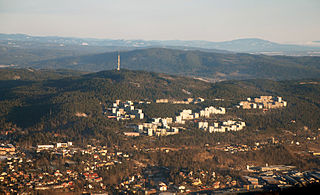
Romsås is a neighborhood in the city of Oslo, Norway. Located northeast of Groruddalen, at the edge of Lillomarka, Romsås was formerly its own borough but was merged into the larger borough of Grorud on January 1, 2004. The name Romsås originated with the Romsås farm which by 1850 was one of the biggest farms in Østre Aker.

Oslo Cathedral — formerly Our Savior's Church — is the main church for the Church of Norway Diocese of Oslo, as well as the parish church for downtown Oslo. The present building dates from 1694 to 1697.

Hoff Church is a parish church of the Church of Norway in Østre Toten Municipality in Innlandet county, Norway. It is located in the village of Kraby, just east of the municipal centre of Lena. It is the church for the Hoff parish which is part of the Toten prosti (deanery) in the Diocese of Hamar. The white, stone church was built in a long church design during the 12th century using plans drawn up by an unknown architect. The church seats about 332 people.

Hallvard Vebjørnsson, commonly referred to as Saint Hallvard, is the patron saint of Oslo. He is considered a martyr because of his defence of an innocent thrall woman. His religious feast day is 15 May.

The Old Bishop's Palace in Oslo was the residence of the Roman Catholic bishops of Oslo. The estate is located in what is now called Gamlebyen in Oslo, Norway. Various remnants of the medieval bishop's original palace are still visible.

Hovedøya Abbey was a medieval era Cistercian monastery on the island of Hovedøya in Oslofjord outside of Oslo, Norway.

The former Norwegian Catholic diocese of Hamar existed from 1152 to 1542, when the Protestant Reformation turned it into a bishopric of the Lutheran state church. The cathedral see was at Hamar, and the diocese included the (modern) counties of Hedmark, Oppland, and the middle part of Buskerud. It also included some parts of Telemark.

Ragnhild Butenschøn, née Jakhelln was a Norwegian sculptor. She was especially known for her church art.

Alf Rolfsen was a Norwegian painter and muralist.

St. Mary's Church was a medieval church located in Oslo, Norway. The church ruins are located in Middelalderparken near the neighborhood of Sørenga in the borough of Gamlebyen.

Håkon Andreas Christie was a Norwegian architectural historian, antiquarian and author. Together with his wife, Sigrid Marie Christie he worked from 1950 on the history of Norwegian church architecture, particularly stave churches. Their research resulted in Norges Kirker which consisted of seven major volumes covering churches in Østfold, Akershus and Buskerud.

St. Edmund's Church is a small church in Møllergata in Oslo, Norway. It was built in 1883–84, and is home to the Norwegian congregation of the Church of England. The church was consecrated by the Bishop of Fulham on 27 July 1884.

Grønland Church is a church located in the neighbourhood of Grønland in the borough of Gamle Oslo in Oslo, Norway.

St. Clement's Church was one of the Roman Catholic parish churches of Oslo, Norway. Ruins of St. Clement's Church are now exposed and included as part of Middelalderparken in the inner city of Oslo (Gamlebyen). It was located between the former Klemetsallmenningen and Østre strede. It is south of the ruins of Oslo Kongsgård estate and St. Hallvard's Cathedral.

St. Margaret's Church was a medieval stone church located on the outskirts of Oslo, Norway.

The Old Town of Oslo is a neighbourhood in the inner city of Oslo, Norway, belonging to the borough of Gamle Oslo and is the oldest urban area within the current capital. This part of the capital of Norway was simply called Oslo until 1925 while the city as a whole was called Kristiania. Oslo's old town was established with the urban structure around the year 1000 and was the capital of Norway's dominion in 1314. The main Old Town area has several ruins of stone and brick lying above ground, and large amounts of protected culture underground. The core area also has listed 1700s buildings. Towards Ekeberg slope and further up are some 17th and 18th-century wooden houses that are zoned for conservation under the Planning and Building Act, though there exist in the Old Town many four-storey brick houses, built at the end of the 1800s, and some heritage railway buildings from different eras.

The Holy Cross Church was a small medieval parish church for the northern part of the Old Town of Oslo, Norway. The ruin was rediscovered in 1922 and is now a part of Minneparken containing the ruins of the church and the larger St. Hallvard's Cathedral.

Minneparken is situated in Gamle Oslo adjacent to Oslo torg at Gamlebyen in Oslo, Norway. The park is bounded by St. Hallvards plass and Oslo gate in the west, Bispegata in the south, St. Hallvards gate in the southeast, Egedes gate in the east and Arups gate in the north.

Gerhard Fischer was a Norwegian architect and archaeologist.






















